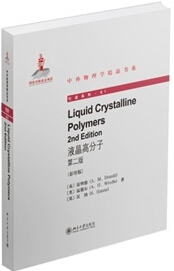
Liquid Crystalline Polymers (2nd edition)
[Book Description]
The book takes the reader through the theoretical underpinnings to real-world applications of LCP technology in a logical, well-integrated manner. A chapter on liquid biopolymers has been introduced, whilst the in-depth discussion on applications describes not only maturing fields of high strength structural LCPs, but also a detailed analysis of the developing area of functional materials. The in-depth coverage and detailed glossary establishes this as an indispensable text for graduate students and researchers in the polymer field, as well as being of interest to those working in chemistry, physics and materials science.
[Table of Contents]
Preface to first edition page ix
Preface to second edition xiii
Part I Fundamentals 1
1 Liquid crystalline polymers: a brief history 3
1.1 From rigid-rods to main-chain polymers 3
1.2 The development of side-chain liquid crystalline polymers 5
1.3 New trends: networks and elastomers 6
1.4 Theoretical underpinnings 7
1.5 A bright future for liquid crystalline polymers 7
2 Terminology and concepts 11
3 Stability of liquid crystalline polymers 68
3.1 Introduction 68
3.2 Factors limiting liquid crystallinity in rigid rod-like molecules 71
3.3 Control of mesophase stability in main-chain thermotropic liquid
crystalline polymers 75
3.4 Lyotropic rigid-rod polymers 91
3.5 Polymers with mesogenic side-chains 101
3.6 Liquid crystalline polymers with more complex molecular architectures 111
4 Theories of liquid crystallinity in polymers 133
4.1 Introduction 133
4.2 Steric theory of rod-like liquid crystals 134
4.3 Virial theories: the Onsager approach 136
4.4 Flory's lattice model 148
4.5 Orientation dependent interactions: the Maier-Saupe theory 161
4.6 Theories for main-chain polymers with semi-rigid chains 168
4.7 Theories of side-chain liquid crystalline polymers 193
4.8 Phenomenological theories of phase transitions 200
5 Local order and classification 229
5.1 Introduction 229
5.2 Nematic polymers 229
5.3 Cholesteric polymers 244
5.4 Smectic polymers 255
5.5 Other aspects of optical texture 274
5.6 Crystallisation in liquid crystalline polymers 277
6 Distortions and defects 292
6.1 Introduction 292
6.2 Distortions 292
6.3 Disclinations and point singularities: a general introduction 304
6.4 Disclination structure in planar geometry 305
6.5 Disclinations and point defects in three dimensions 315
6.6 Surface disclinations and walls 340
6.7 Defects in smectics and cholesterics 345
6.8 What is special about polymeric liquid crystals? 351
7 Biological liquid crystalline polymers 357
7.1 Introduction 357
7.2 Polyelectrolytes 358
7.3 Helicoids: also known as pseudomorphs 360
7.4 Lyotropic main-chain polymers 363
7.5 Side-chain liquid crystalline polymers 375
7.6 Concluding remarks 380
8 Flow and applied fields 385
8.1 Introduction 385
8.2 Flow fields in liquid crystalline materials 387
8.3 The Leslie-Ericksen theory for viscous flow of nematics 396
8.4 Miesowicz viscosities 399
8.5 The role of texture in liquid crystals subject to shear flow 402
8.6 Shear flow of liquid crystalline polymers 408
8.7 Mechanical response of liquid crystalline elastomers 417
8.8 Response of liquid crystalline polymers to electric and magnetic fields 422
8.9 Instabilities 430
Part II Applications 437
9 Processing and applications of structural liquid crystalline polymers 439
9.1 Two perspectives on the application of liquid crystalline polymers:
an introduction to Chapters 9 and 10 439
9.2 Rheology 440
9.3 Processing and the consequences of flow alignment 457
9.4 Liquid crystalline polymers as structural materials 460
9.5 Liquid crystalline polymers in blends and composites 483
9.6 Commercial exploitation of structural liquid crystalline polymers 486
10 Applications of functional liquid crystalline polymers 504
10.1 Introduction 504
10.2 Liquid crystalline polymers as optoelectronic materials 504
10.3 Liquid crystalline polymers in displays 507
10.4 Semiconducting liquid crystalline polymers 516
10.5 Laser writeable devices 523
10.6 Non-linear optical applications 526
10.7 Sensors and actuators 540
List of symbols 549
Molecule index 558
General index 574

 新书报道
新书报道